Rajasthan Board RBSE Class 11 Biology Chapter 35 Earthworm
RBSE Class 11 Biology Chapter 35 Multiple Choice Objective Questions
Question 1.
First segment of earthworm is-
a. Prostomium
b. Peristomium
c. Pygiduim
d. Clitellum
Question 2.
Select female reproductive organ-
a. Seminal vesicle
b. Spermathecae
c. Accessory glands
d. Prostate glands
Question 3.
Which of the following structure of adult earthworm is found in 18th segment and not in 15th segment.
a. Nephridia
b. Setae
c. Mucous glands
d. Prostate gland
Question 4.
Where the respiratory pigment forms in earthworm-
a. External skin
b. Heart
c. Blood glands
d. Lymph glands
Question 5.
Site of fertilization in earthworm-
a.Cocoon
b. Seminal vesicle
c. Oviduct
d. Moist soil
Answers :
1. b
2. b
3. d
4. c
5. a
RBSE Class 11 Biology Chapter 35 Very Short Answer Questions
Question 1.
Write scientific name of earthworm.
Answer :
Pheretima posthuma
Question 2.
Site of fertilization in earthworm.
Answer :
Cocoon
Question 3.
Which segments of earthworm bear testes?
Answer :
10th & 11th segments
Question 4.
What is the length of a mature earthworm?
Answer :
15 to 20 cm
Question 5.
What is the main function of gizzard?
Answer :
grinding of food
Question 6.
Which blood vessel in earthworm functions as true heart?
Answer :
dorsal blood vessel
Question 7.
Give the name of structure found in the intestine of earthworm meant for absorption.
Answer :
Typhlosole
Question 8.
Where the calciferous glands are found in earthworm?
Answer :
Stomach
Question 9.
Between which segments, first inter segment septum is found in earthworm.
Answer :
4/5 segments
Question 10.
Name the cells in earthworm which function like vertebrate liver.
Answer :
Chlorogogen cells
Question 11.
What is the name of excretory unit in earthworm?
Answer :
Nephriduim
Question 12.
The reason of brown color of skin of earthworm.
Answer :
Porphyrin
Question 13.
Which muscle layer is most developed in the gizzard of earthworm.
Answer :
circular muscles
Question 14.
Segment of earthworm in which ovaries are situated?
Answer :
13th segment
Question 15.
Name the ecotonephric nephridia in earthworm.
Answer :
Integumentary nephridia.
RBSE Class 11 Biology Chapter 35 Short Answer Questions
Question 1.
What do you mean by metameric segment?
Answer :
When body is divided both internally & externally to form separate chambers.
Question 2.
What will happen if the pores of 14th segment are closed by wax?
Answer :
Ova will not release into the cocoon.
Question 3.
Which cell types are found in the body wall of earth-worm.
Answer :
Epidermis
It is a single-layered and it is made up of columnar cells.
Most of it’s cells are called as supporting cells. Some of the cells modify to form gland cells which are of two types-
- Mucous gland cells—They are found uniformly distributed all over the body. They secrete mucus to keep the body moist.
- Albumin gland cells—They are less in number and they secrete albumin. Most of the albumin gland cells are found in the body wall of the clitellum.
- Some of the epidermal cells modify to form sensory cells. In addition, the epidermis also has few basal cells which are small and round /cone-shaped.
Question 4.
Why earthworm is called as friend of farmers?
Answer :
The burrows of earthworms make the soil porous like honeycomb which serves better respiration & penetration of the roots of the plants.
Question 5.
Explain the process of ingestion in earthworm.
Answer :
Feeding : The earthworm feeds with the help of the buccal cavity & the pharynx. The buccal cavity protrudes repeatedly to carry in the soil. Simultaneously, the pharynx sucks the soil by acting as suction pump.
Question 6.
What will be the effect on digestion if the calciferous glands of stomach stop functioning?
Answer :
There will be no further digestion in the alimentary canal, as it needs alkaline pH.
Question 7.
Differentiate septal & integumentary nephridia.
Answer :
Septal nepridia are holonephric & are found attached from 15/16 septum to last. The integumentary nephridia are V-shaped, small & not holonephric. They are ectonephric.
Question 8.
Draw a labelled diagram of spermatheca and write its role.
Answer :
Spermathecae :
It has four pairs of spermathecae which are situated ventro-laterally in 6th, 7th, 8th & 9th segments. They open outside through the spermathecal pores which are found ventro-laterally in 5/6, 6/7, 7/8 & 8/9 inter segment grooves.
Question 9.
Explain the process of cocoon formation in earthworm.
Answer :
Cocoon Formation :
Cocoon in the earthworm is formed by the clitellum. The gland cells of the modified epidermis of the clitellum secrete a slimy substance after the copulation which on air contact form a girdle around the clitellum. Soon, the clitellum receives albumin protein which acts as nutrient for the developing embryo. Now, many ova are released into the girdle. It is believed that the girdle contracts to mount pressure on the oviducts which results in the release of ova.
Question 10.
What is the relation of spermathecae with reproduction?
Answer :
They store sperms after copulation.
Question 11.
Earthworm is bisexual than why self fertilization is not found.
Answer :
To prevent genetically disorders. Moreover, it is protandrous.
Question 12.
Give an account of coelomic corpuscles in earthworm.
Answer :
The body cavity of the earthworm is full of coelomic fluid which is milky white & alkaline (pH-7 to 9). The coelomic fluid consists of water, salts & proteins. In addition, there are four types of coelomic corpuscles which are as follows –
- Phagocytes or Eleocytes or Granulocytes or Leucocytes or Amoebocytes
- Circular cells
- Mucocytes
- Chlorogogen cells
Question 13.
Explain process of locomotion in earthworm.
Answer :
It exhibits mainly aerobic respiration but it also performs anaerobic respiration. The earthworm lacks definite respiratory organs. Hence, the exchange of gases takes place through the moist body surface. In absence of oxygen, the earthworm can survive maximum for 24 to 30 hours. If the body surface gets
Question 14.
Why earthworm respires through the skin?
Answer :
It respires through the skin as it lacks definite respiratory organs.
Question 15.
Give the main functions of body wall in earthworm.
Answer :
It protects the body, acts as respiratory organ & bears sense organs.
RBSE Class 11 Biology Chapter 35 Essay Type Questions
Question 1.
Describe the digestive system in earthworm. Give suitable diagram.
Answer :
Alimentary Canal :
It is a simple & straight tube between the mouth & the anus. The earthworm exhibits tube within a tube arrangement because of the position of the alimentary canal.
The alimentary canal has following parts-
- Mouth : It is terminal & crescentric.
- Buccal cavity : It is found in first three body segments and is a protrusible structure which helps in locomotion & in the ingestion of food.
- Phrynx : It is a muscular & bulb-like structure which is found in 3rd & 4th segments. It’s wall is thick & muscular, and it’s dorsal side is comparatively more thicker. It’s dorsal side consists of unicellular salivary gland cells & special chromaffin cells. The salivary glands secrete saliva & the chromaffin cells are known to help in the synthesis of saliva. A horizontal shelf divides the lumen of the pharynx into two chambers viz.-
(a) Dorsal or Salivary chamber
(b) Ventral or Conduction chamber
The pharynx acts as a sucking organ due to presence of radial muscles. - Oesophagus : It is a small & narrow’ tube which is found in 5th, 6th & 7th segments. Internally, it has many transverse folds.
- Gizzard : It is a bulb-like structure which is found in 8th segment. It’s wall has a thick layer of circular muscles. It’s cavity is lined by a columnar epithelium which secretes a hard cuticle lining. The cuticle consists of mainly chitin. The gizzard is meant to grind the food.
- Stomach : It is a thin & tubular structure which is found in 9th to 14th segments. It’s wall is glandular & it extends internally to form longitudinal folds. It has sphinctors at both the ends. The walls of the stomach has special calciferous gland cells. They secrete calcareous substance which neutralizes the humic acid & makes the medium alkaline.
- Intestine : It is a sacculated & tubular structure which extends irom 14th to last segment. It is divisible into three parts-
(a) Pre-typhlosolar region : It is found in 14th to 26th segments & it is without typhlosole. In 26th segment, it gives out a pair of intestinal caecae which extend upto the 23rd segment. The walls of the intestinal caecae are thin. According to Chen & Puh, the intestinal caecae secrete digestive enzymes.
(b) Typhlosolar region : This region is found from 27th segment to the segment except last 25 segments. It has a typhlosole which is an internal longitudinal fold in the mid-dorsal position. The typhlosole provides increased surface for the absorption of the digested food.
(c) Post-typhlosolar region: This part is found in the last 25 segments. It is without typhlosole. This part is also called as rectum. - Anus : It is a longitudinal slit-like aperture.
Question 2.
Explain blood vascular system in earthworm.
Answer :
Blood Vessels –
The blood vascular system includes three main blood vessels and many assisting blood vessels which are as follows-
Main blood vessels :
- Dorsal BV –
It is found in complete body length mid-dorsally to the alimentary canal. It appears to be a dark line from the outside. It’s walls are thick, muscular & contractile. Hence, the dorsal B.V. functions like a heart.
It is provided with valves and there is a pair of valves in each segment The blood in the dorsal BV flow’s from posterior to anterior direction.
It acts as collecting BV from last to 14th segment and in the first thirteen segments, it acts as distributing B.V. In first thirteen segments, it supplies blood to the alimentary canal & reproductive organs found in these segments. From last to 14th segment, it collects blood from the body wall, intestine, reproductive organs & subneural B.V. - Ventral blood Vessel –
It is situated mid-ventrally to the alimentary canal from 2nd to last body segments. It is thin-walled, less muscular & non-contractile and it is without valves. The blood flows from forward to behind.
It acts as a distributing blood vessel in the whole body length. It provides blood to the body wall & to the integumentary nephridia. It also supplies blood to the intestine, septa, septal nephridia & reproductive organs in 14th to last segments. - Lateral-oesophageal and Sub-Neural blood Vessel –
Sub neural BV is found mid-ventrally just below’ the alimentary canal from 14th to last segments. It is thin-walled, non-muscular & non-contractile blood vessel which is without valves.
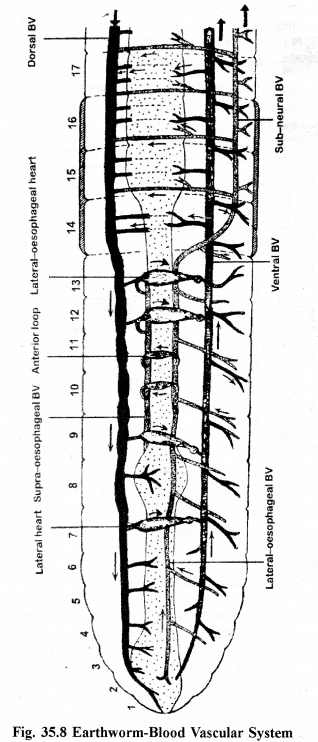
The blood in the sub-neural BV flows from forward to behind & it acts as a collecting B.V.
In 14th segment, the sub-neural BV bifurcates to form two lateral oesophageal blood vessels. They are situated on both the sides of the alimentary canal in first thirteen segments.
The lateral oesophageal BVs. collect blood from the organs found in first thirteen segments. The blood flows from forward to behind.
Accessory Blood Vessels :
The blood vascular system has following accessory blood vessels-
- Supra-gastric or Supra-oesophageal BV –
It is a small blood vessel which is found in 9th to 14th segments just above the stomach. It collects blood from the stomach. The blood flows from forward to backward.
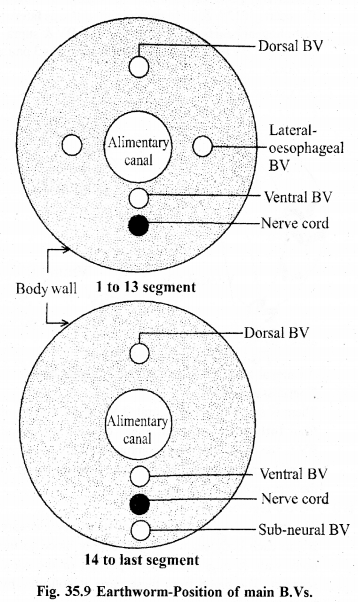
- Ring Vessels –
There are 6 pairs of small ring vessels which are found in the wall of the stomach. They collect blood from the stomach & carry it into the supra-gastric B.V. - Anterior loops –
There are 2 pairs of anterior loops which are found in 10th & 11th segments. They connect both the lateral- oesophageal blood vessels to the supra-oesophageal B.Vs. The anterior loops are without loops & are non- contractile. - Hearts –
It has four pairs of hearts which are tubular & non- contractile. They are found in 7th, 9th, 12th & 13th segments. The hearts of the 7th & 9th segments are called as lateral hearts. They connect dorsal BV to the ventral BV. Each lateral heart has 4 pairs of valves. The hearts of 12th & 13th segments are called as latero- oesophageal hearts. They connect dorsal BV & supra- oesophagel BV to the ventral BV. Each heart has 3 pairs of valves.
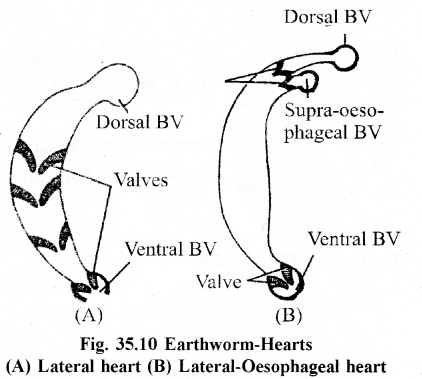
- Commissural BV –
There is a pair of commissural B.Vs. in each segment from 14th to last segment. They connect sub-neural BV to the dorsal BV. Each commissural B.V gives out a small septo-intestinal B.V. which supplies blood to the septum & the intestine. - Ventro-tegumentary BV –
The ventral BV gives out a pair of ventro-tegumentary BV in each body segment. They supply blood to the body wall & integumentary nephridia of the same segment. The blood from these parts is collected by the dorsal B.V. - Ventro-intestinal & Dorso—Intestinal B.Vs. –
The ventral B.V. gives out one ventro-intestinal B.V. in each segment from 14th to the last segment. It supplies blood to the intestinal wall. In the intestinal wall, it forms two blood pluxes viz.— outer intestinal plux & inner intestinal plux. Both the pluxes remain connected to each other. The blood from the intestinal wall is collected by dorso-intestinal B.Vs. Each segment has 2 pairs of dorso-intestinal B.Vs.
Question 3.
Give the nature of eathworm concern to excretion. Give the staicture of septal nephridia in earthworm
Answer :
Excretion –
The earthworm is a ureotelic animal but it excretes a mixture of ammonia, urea & creatinine. According to Dr. Bahl, the ratio of urea, ammonia & creatinine is 55%, 40% & 5% respectively. During rainy season (breeding season) the earthworm becomes ammonotelic. The primary excretory organs are nephridia which are of 3 types viz.—
- Integumentary nephridia.
- Pharyngeal nephridia
- Septal nephridia
1. Integumentary Nephridia –
They are found in the body wall of all body segments except the first six segments.
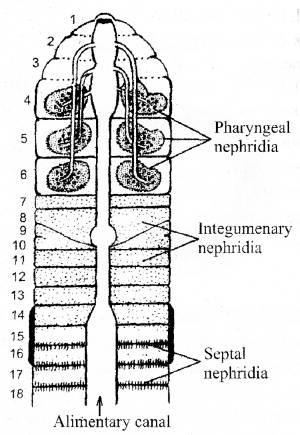
There are 200 to 250 nephridia in each segment but in the clitellum their number is 10-times more i.e. in each clitellar segment their number is 2000 to 2500. Hence, they form a nephridial forest in the clitellum. These nephridia open outside directly. Hence, they are called as exonephric or ectonephric nephridia. They are smallest nephridia which are V-shaped. They lack nephrostome, hence they are not holonephridia.
2. Pharyngeal nephridia –
It has 3 pairs of pharyngeal nephridial tufts which are found in 4th, 5th and 6th segments. Each group consists of about 100 fused nephridia. They are without nephrostome & neck. Hence, they are holonephric. These nephridia open into the alimentary canal with the help of three pairs of common duct. Hence, they are enteronephric or endonephric. They are also called as pepto-nephridia. The nephridial tufts of 6th segment open into the alimentary canal of 2nd segment, of 5th segment into 3rd segment & nephridia of 4th segment open into the alimentary canal of 4th segment.
3. Septal nephridia –
They are complete i.e. holonephric and are attached to both the sides of the septa from 15/16 septum to the last septum & remain freely suspended in the body cavity There are 40 to 50 septal nephridia on one side of the septum which are attached in 2 groups of 20-25 nephridia. Hence, each segment has 80 to 100 nephridia. However, in 15th & last segment their number is 40-50. These nephridia open into the intestine. Hence, they are endonephric or enteronephric type. The septal nephridia are also called as typical nephridia.
Structure of septal nephridia : It consists of following parts –
- Nephrostome : It is a funnel-shaped structure that remains bounded by two lips. The lips are made up of ciliated marginal cells. There are 8 or 9 large marginal cells in the upper lip and 4 or 5 small marginal cells in the lower lip. The lumen of the funnel is like an intra cellular tunnel which is found in a large central cell. This tunnel opens into the neck.
- Neck : It is a small & narrow tube which is ciliated internally.
- Nephridial body : It Is the main part of the septal nephridium which has 2 parts
(a) Straight lobe
(b) Twisted lobe - Terminal duct : It originates from the proximal part of the twisted lobe. It has only one tubule.
- Septal excretory ducts : The terminal ducts of 20-25 septal nephridia of one group open into one septal excretory duct. Hence, there are 4 septal excretory ducts in each segment.
- Supra-intestinal excretory canals : There are two supra-intestinal excretory canals which are situated mid-dorsally on the intestine from 15th to the last segment.
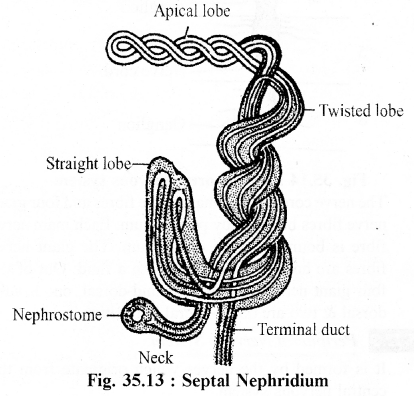
The septal excretory duct of one side opens into the supra-intestinal excretory canal of the same side. Any one out of the two supra-intestinal excretory canal opens into the intestine in each segment through a minute duct. Hence, the intestine has one excretory pore in each segment from 15th to the last segment.
Question 4.
Draw a labelled diagram of reproductive system of earthworm.
Answer :
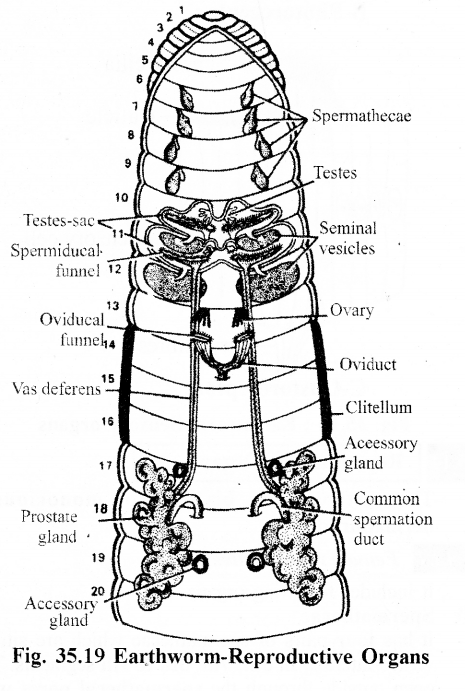
Question 5.
Explain the structure of body wall of earthworm with the help of diagram.
Answer :
Body wall :
It’s body wall includes cuticle, epidermis, musculature & peritoneum which are as follows –
Cuticle –
It is the outermost layer which is glossy & appear to be light yellow in colour. It is non-chitinous and has two layers of collagen fibres.
Epidermis –
It is a single-layered and it is made up of columnar cells.
Most of it’s cells are called as supporting cells. Some of the cells modify to form gland cells which are of two types-
- Mucous gland cells—They are found uniformly distributed all over the body. They secrete mucus to keep the body moist.
- Albumin gland cells—They are less in number and they secrete albumin. Most of the albumin gland cells are found in the body wall of the clitellum.
- Some of the epidermal cells modify to form sensory cells. In addition, the epidermis also has few basal cells which arc small and round /cone-shaped.
Musculature –
The musculature has three sub-layers which are as follows—
- External layer of circular muscles.
- Middle layer of longitudinal muscles.
- Inner layer of circular muscles.
Tire thickness of the outer layer of circular muscles is more than the inner layer of circular muscles. The porphyrin pigment is found in the outer layer of circular muscles. The layer of the longitudinal muscles is comparatively thicker & they are found in parallel bundles.
Peritoneum –
It is also called as coelomic epithelium. It is the innermost layer which is made up of flat cells. The body wall protects the body and gives shape to it. The body w all of the clitellum secretes the cocoon during the breeding season.